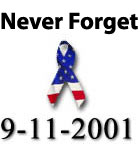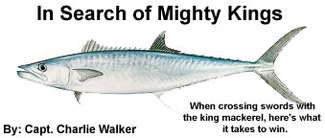
Eight AM; Tuesday morning. High tide is at 10:30 AM. The boat is loaded with tackle, ice, lunch, and 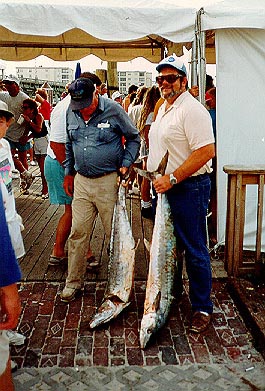 fishermen. On our way down the ICW to Pass-a-grille Pass, we see greenbacks on the surface near the bridge pilings. After a few tosses of the cast net, we have several hundred in the well and continue around the corner to the Gulf of Mexico. As we round the corner and head out the pass, we see that we are only one of several hundred boats that had the same idea. Just as soon as we cross the bar, we reduce speed, get the baits in the water, and begin trolling. Looking around us, we can easily count over three hundred other boats doing the same thing - trolling for king mackerel. On any day of the week during the kingfish runs, you could see the same sight. Hundreds and hundreds of boats, all slow trolling the Gulf waters for king mackerel. If you were in an airplane flying down the beaches from Tarpon Springs to Venice, you would not be able to count the thousands of boats seeking these toothy speedsters.
fishermen. On our way down the ICW to Pass-a-grille Pass, we see greenbacks on the surface near the bridge pilings. After a few tosses of the cast net, we have several hundred in the well and continue around the corner to the Gulf of Mexico. As we round the corner and head out the pass, we see that we are only one of several hundred boats that had the same idea. Just as soon as we cross the bar, we reduce speed, get the baits in the water, and begin trolling. Looking around us, we can easily count over three hundred other boats doing the same thing - trolling for king mackerel. On any day of the week during the kingfish runs, you could see the same sight. Hundreds and hundreds of boats, all slow trolling the Gulf waters for king mackerel. If you were in an airplane flying down the beaches from Tarpon Springs to Venice, you would not be able to count the thousands of boats seeking these toothy speedsters.
The above scenario occurred every spring and fall until the mid-seventies. Every year the runs became smaller and smaller - until finally the bottom dropped out completely.
A Bit of History
In January, 1978, the west Florida stock of king mackerel were bunched up in their traditional wintering area of Florida Bay, north of the keys. Suddenly, there were dozens of fast boats surrounding the schools with miles and miles of monofilament gill net, effectively covering the water column from the surface to the bottom. The trapped fish had nowhere to go; no option other than to swim headlong into the nearly-invisible invader – hopelessly entangling themselves in the deadly mesh curtain. Within a few hours, all the boats had filled their holds to capacity with tons of kingfish each. At least five fishermen were so greedy that they overfilled their boats, and all five sunk on the spot.
There were so many fish left in several of the nets, that there was no way for the netters to carry them back to shore. They did the only thing that they could do, cut their nets loose and allow them to sink to the bottom of Florida Bay, still full of dead and dying kingfish. It is a very good possibility that these nets are still on the bottom of Florida Bay, continuing to catch and kill fish today. I have not heard of anyone attempting to salvage them since that black day in January. This story was told by several of the crewmembers that had participated in the fishery and had been in Florida Bay that day. It was confirmed later the same week by divers that managed to take photographs of the fish stacked on the bottom like cordwood over miles and miles of ocean bottom.
The hardcore recreational kingfishermen of those days, this writer included, had been noticing a decline in the catches of large kingfish for several years. In the Tampa Bay area, Gene Turner, a St. Petersburg Beach boat builder, and to some, the "godfather of kingfishermen", had been talking to anyone that would listen about the decline in kingfish runs. He spent hours and hours each week in the offices of politicians and on the telephone to beauracrats and biologists alike within the Dept. of Natural Resources, trying to convince them that there was a problem with the kingfish stocks in the Gulf of Mexico. Finally Gene joined forces with the relatively new Florida League of Anglers, formed in the early seventies by Lyman Rogers, Karl Wickstrom, Vic Dunaway, Fritz Stopplebein, Al Pfleuger, Rollie Franzen, Harlan Frankland and others. Finally, the ball really started rolling toward conservation - or at least that was what everyone hoped and thought.
After the Florida Bay slaughter, there were virtually no kingfish caught by recreational fishermen on the Gulf coast during the spring of 1978. At that time, the National Marine Fisheries Service was the only agency responsible for setting quotas on commercial and recreational catches in the Gulf of Mexico off Florida. Even though there were only about one million pounds of kingfish landed after the Florida Bay incident, the NMFS continued to side with the commercial industry, stating that there was no problem with the stocks.
Plenty of answers…but no solutions
NMFS responded to the recreational fishermen’s concerns by setting the annual quota at 38 million pounds, with 28 million pounds allowed for recreational fishermen and 9 million pounds allowed for the commercial industry. The commercials never came close to reaching their quota after Florida Bay, and of course the recreationals caught almost nothing. The only thing that this accomplished was to allow the politicans in Tallahassee to brush off the cries of the recreational lobby by telling them that there was no problem. Many of these same politicians were, to put it gently, in very close alliance with the commercial fishing industry. The legislators that we elected simply said that if there were a problem, NMFS wouldn’t have allowed the recreational fishermen 28 million pounds of fish. Slowly the quota was lowered over the years until it could be reached in less than two weeks of commercial netting. The commercials had and still have the knowledge and equipment to take virtually all the fish that are in the Gulf in a very short time. Drift gill nets were finally eliminated in the late eighties, but to this day, the NMFS still sides with the commercial industry and refuses to remove all the gill nets from the kingfish in federal waters.
Finally…A ray of hope
One of the good things that was accomplished, over a period of many years, by Gene Turner and the Florida League of Anglers, was the establishment of a bag limit for kingfish. In 1985, when the late George Barley was chairman of the Florida Marine Fisheries Commission, a bag limit of two fish was placed o n ALL fishermen to eliminate the slaughter in state waters by the netters. During a meeting of the MFC in Naples, FL, Gene Turner was the only spokesman for the recreational anglers, and fought a pitched battle with Gene Raffield, Billie Sandifer, and John Riggs - all commercial fishermen - but finally won the commission over. This was the beginning of a slow comeback for the king runs on the west coast of Florida. Over the last few years, we’ve seen a steady increase in the numbers of kingfish in the Gulf, and 1997 has continued this trend. The nets still must be eliminated in all waters if we are ever to see any real numbers of kings during their spring and fall runs again. (Ed note: In 2009 the kinfish run was still very small compared to the 70's but some decent fish are being caught in the Tampa Bay area each season, you just have to really work for them. As long as king mackerel netting is allowed in Federal waters in the Keys, we will not have any real 'glory days' again.)
Now that you know the history of the kingfish fishery, I will tell you a little bit about how to catch them. The runs are not anything like they used to be, but if you know when, where, and how to fish for king mackerel, you should be able to have a little luck.
Gearing up for battle
The easiest way to catch kingfish for the novice or the experienced angler is to troll with silver 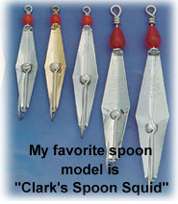 spoons. My favorite spoon model is "Clark’s Spoon Squid", because it was developed in this area and is very durable. The lure’s double chrome plating and high-quality salt-water hook helps it stand up to the corrosive effects of salt water. You will need at least three sizes, depending on the size of the bait fish that the kings are feeding on: #0, #2, and #4. The #0 is small enough to look like a glass minnow (anchovy), the #2 is about two inches long, and the #4 is about five inches long. This variety of sizes will get you through just about any day of trolling for mackerel. Of course you will need several of each size and a small roll of either #3 or #4 coffee colored, single strand, stainless steel leader wire.
spoons. My favorite spoon model is "Clark’s Spoon Squid", because it was developed in this area and is very durable. The lure’s double chrome plating and high-quality salt-water hook helps it stand up to the corrosive effects of salt water. You will need at least three sizes, depending on the size of the bait fish that the kings are feeding on: #0, #2, and #4. The #0 is small enough to look like a glass minnow (anchovy), the #2 is about two inches long, and the #4 is about five inches long. This variety of sizes will get you through just about any day of trolling for mackerel. Of course you will need several of each size and a small roll of either #3 or #4 coffee colored, single strand, stainless steel leader wire.
Choosing your weapons
Your kingfish tackle should be at least twenty-pound test and your reel should hold at least three hundred yards of line. Please make certain that your reel’s drag is silky-smooth - without sticks, clicks or chatters of any kind. You will be setting your drag at about three to five pounds, and at that setting a decent sized king can take over two hundred yards of line in just a few seconds. That is why we call the big ones "smokers" - not because they taste best smoked, but because they have "smoked" many a reel. I prefer forty-pound test line, because I often fish near crab buoys. The line connecting the trap to the buoy will cut smaller test line when a king runs around it – which they always seem to do. You will also lose some forty-pound tackle, but you will at least have a better chance to unwrap the heavier line before it breaks. You will need to learn how to tie a "haywire twist" with the wire to attach it to the spoon and to a small black forty pound test barrel swivel, using about twelve inches of wire between the two. When I am tournament fishing, I will use five-foot long wire leaders, but for recreational fishing, one foot will suffice to keep the kings’ sharp teeth away from your monofilament line.
The time of the kings
Once you have acquired all the tackle that you will need for a day’s trolling, you simply need to wait for either the spring or fall of the year to roll around. The prime times in the Tampa Bay area 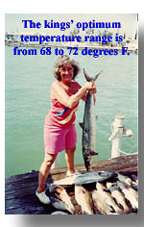 are April 15th until about the end of May, and Thanksgiving through the middle of December. The easiest way to know when the kings should be in your area is to keep an eye on the water temperature in the Gulf. The kings’ optimum temperature range is from 68 to 72 degrees F. Higher or lower temperatures send the kings north, south or west in search of that magic 68-72 range. Of course, the best places to fish are wherever the bait is most plentiful. Usually this is near hard bottom, in the passes, or even right up next to the beach. Suncoast pier fishermen catch their share of kings within a stone’s throw of shore.
are April 15th until about the end of May, and Thanksgiving through the middle of December. The easiest way to know when the kings should be in your area is to keep an eye on the water temperature in the Gulf. The kings’ optimum temperature range is from 68 to 72 degrees F. Higher or lower temperatures send the kings north, south or west in search of that magic 68-72 range. Of course, the best places to fish are wherever the bait is most plentiful. Usually this is near hard bottom, in the passes, or even right up next to the beach. Suncoast pier fishermen catch their share of kings within a stone’s throw of shore.
Choosing your spot
If you are looking for a place to troll for the first time, and are not familiar with the area, look for birds "working" on the surface – diving into the water in search of baitfish. Pelicans are the bird of choice to watch for, since they can be seen from farther away than gulls, and they also will feed deeper in the water than a gull will. If you see bait "showering" on the surface, even without bird activity, begin fishing that area. Bait will usually only come to the surface and shower if something bigger is eating them below. In their frenzy to escape the predator, they actually break the water’s surface before turning downward – that’s showering. If you see large clouds of bait on your fish finder, begin trolling that area. Kingfish are like any other wild animal, they will only stay in an area as long as there is plenty of food to keep them full.
The proper way to troll spoons near a school of bait is to get your lines in the water as you approach the bait school, approximately twenty feet behind the boat for the closest lure and fifty to seventy five feet back for the furthest lure. Never troll two baits the same length back because they will tangle as you turn to circle the school. Stagger the lengths, with the longer lines on the outsides and the shorter line trolled from the center. As you approach the bait school at four to six knots, be sure you steer the boat to avoid running over the school. You want to stay on the outside of the school and circle them in order to catch fish that are feeding on them. If you run right through a bait school, you will split them into two or more schools and drive them deeper in the water, and you will not know which way they are going. If, after circling the school several times, you are not getting strikes, it is time to go on and look for another batch of bait.
Trolling etiquette
One note here: if you come upon a group of boats that are trolling an area, stand away from them long enough to see the pattern that everyone is steering. It will usually be somewhat circular and everyone should be going in the same direction. It’s very much like driving your car on a one way street. Don’t try to buck the traffic and go the opposite direction, just go with the flow at the same speed as everyone else. Never, never, never cut through a group of boats that are trolling an area in a circular motion just because you want to get to the other side. Either go around them, or join them and troll for awhile until you get to the other side of the pack. If you cut through the middle of a group of boats, you will make enemies of everyone in that group, and you never know who might be watching you or how mad they might get. If you notice that everyone is trolling much more slowly than you, it is probably because they are trolling live bait. In order to troll live bait, you must go as slow as the slowest baitfish can swim. This is so as not to tire them out too quickly. You shouldn’t try to join a group of live baiters when you are pulling spoons, simply stay to the outside of them and go the same direction as they are traveling.
The strike: "Kingfish don’t nibble"
When a kingfish hits your line, you will know it right away. The reel will start screaming and you will lose line at an unbelievable rate. Don’t tighten the drag at this point, if you do, the line will probably part and you will never see your fish. As a matter of fact, don’t even touch the rod, leave it in the rod holder. I have been known to throw large egg sinkers at the anglers on my boat if they do not understand me when I scream at the top of my lungs, "DON’T TOUCH THE @#%!$&^*$ ROD". The rod holder on your boat is the best fisherman that you have aboard. It never jerks the rod nor does it tighten the drag. It simply holds on and lets the rod and reel do the work that they were designed to do - catch fish. Once the initial run slows down, then carefully take the rod from the holder and simply hold it straight up, just the way the rod holder held it. Too many people watch television on Saturday mornings and think that they have to jerk the rod several times to set the hook. This is not the case with kingfish. If you jerk the rod with a king on the hook, you are very likely to tear the hook out of the fish’s mouth , and you will never see him.
Simply crank the reel handle to retrieve line as you smoothly and gently lower the rod tip to about forty five degrees from the vertical, keeping the rod bent at all times. Now stop reeling as you smoothly and gently straighten up and bring the rod back up to vertical. Continue the "dip and crank" and "lift back up" routine, always keeping a bend in the rod, until the fish is at the side of the 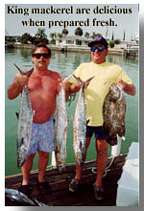 boat and can be gaffed. Congratulations, you have caught yourself a king mackerel… maybe. Bonita, barracuda, cobia, shark, and other species also like 68 to 70 degree water, and they bite the same way.
boat and can be gaffed. Congratulations, you have caught yourself a king mackerel… maybe. Bonita, barracuda, cobia, shark, and other species also like 68 to 70 degree water, and they bite the same way.
No matter what fish you catch, I guarantee that you will have a good time catching it, so either release it or put it in the box for dinner, and continue trolling for kings around the bait schools. King mackerel are delicious when prepared fresh. They have an oily flesh like Spanish mackerel and blue fish, but if grilled or broiled fresh, with some nice seafood seasoning, they are delicious. They also make a fantastic smoked fish spread.


